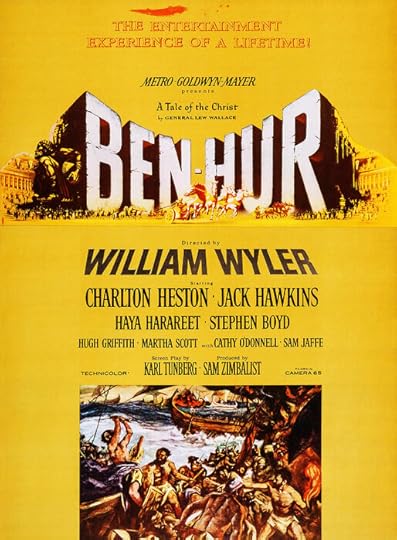Action Oscars – Ben-Hur
Welcome back! This week I’m looking at an older piece of cinema, long considered one of the all-time greats, in part because of one of the most iconic sequences to ever grace the screen.
Ben-Hur (1959)It’s worth noting that no one is formally credited as stunt coordinator on this movie, despite boasting a significant stunt performer team, but veteran stuntman is widely acknowledged as the man who put together the chariot race sequence.

I hadn’t watched the movie since I first saw it as a kid on my Boston-area UHF station (he said before crumbling into a pile of dust and bone fragments), but it was available on Tubi, so I watched it on Easter Sunday — which is appropriate because the station in question often ran it on Easter since the Crucifixion figures into the movie’s climax. Ben-Hur is, curiously, is pitched in an opening title card as “a tale of the Christ,” but Jesus is barely in the film, we never see his face, and he never speaks. He’s more a MacGuffin than a character, and certainly not the main character.
No, that would be Jewish prince Judah Ben-Hur (), who is betrayed by his former best friend Messala (), an ambitious Roman who’s all about subjugating the Jewish people in the emperor’s name. He sentences Ben-Hur to a life of slavery over a crime he didn’t commit, and while serving as an oarsman on a Roman warship, Ben-Hur saves the life of a high-ranking Roman official, Quintus Arrius (). Arrius adopts Ben-Hur out of gratitude, and during his time in Rome, Ben-Hur becomes an ace charioteer. This sets up the sequence that earns this movie the Oscar for Best Stunt Design.
The Moneymaker
Ben-Hur is, overall, not a stunt-heavy film. There are only two major action set pieces, the first being an impressive sea battle (in which a stuntman takes a flaming torch to the face. YOWCH). The second is the great chariot race pitting Ben-Hur against Messala, which is one of the most thrilling, pulse-pounding scenes you’ll ever witness.
The race itself takes place on a physical set occupying 18 acres of land, and runs in real time: nine laps in nine minutes, and that nine minutes took — depending on the source you refer to — five months to nearly a full year to plan and execute; filming alone took up five weeks spread over three months. That included training Heston and Boyd to handle their own chariots; the actors are doing their own stuntwork in the medium and close-up shots. Heston reportedly was a quick study, and he practiced three hours a day every day.
Despite Hollywood legends to the contrary, none of the horses were injured and none of the stuntmen were killed. The most serious injury was suffered by Canutt’s son , Heston’s double for the scene. That moment near the end of the race when Ben-Hur is shot out of the chariot resulted from Joe Canutt failing to hook himself into his safety harness. He wacked his chin pretty hard and legitimately almost got flung out of the chariot. The shot was almost removed from the final film as “unusable,” but a pick-up shot of Heston climbing back into the chariot was added, saving the scene and making it one of the most harrowing moments of an already nerve-wracking sequence.
The chariot race also involved a number of technical challenges for the camera crew, which filmed the close-ups from a car running ahead of the chariots. They learned quickly that the horses were faster than the car on the straightaways. The 70mm lenses had a sweet spot of 50 feet, which meant the cameras could only capture a few seconds of footage before the horses caught up and the cameras lost focus. In the end, for every 263 feet of film shot for the scene, the production ended up with one foot of usable footage — one of the highest ratios of any motion picture ever.
Ben-Hur ended up taking home eleven Oscars, including Best Picture, and it for sure would have won Best Stunt Design if the award had existed back then — and deservedly so.
Other nominees: North By Northwest, Rio Bravo, Pork Chop Hill.



